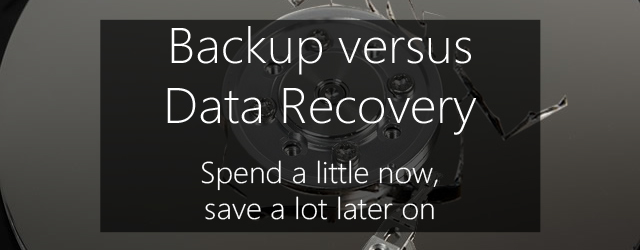Data recovery services are always an option when your business-critical data takes a nosedive. But frankly, if you’re getting to the point where you need them, you’re doing something wrong along the way. Data recovery can work, but it’s going to cost you a lot of money and you’re rarely guaranteed to retrieve all of the data you need.
So what’s the better option? Well, it’s pretty simple. If you can’t afford to lose it, then back it up.
In this article, we’re going to take a look at how a straight-forward, comprehensive backup strategy is going to save your data, your money and your time.
How the dollar costs stack up

The costs of data recovery can vary significantly based on the circumstances of the data loss. But even for a relatively simple, consumer-level recovery, you’re looking at a minimum of several hundred dollars. Heck, even Geek Squad states on their website that costs can exceed $1,450 – and trust us, if you’re recovering data for business purposes, you’re probably not going to Geek Squad!
For business-grade data recovery, the monetary costs can quickly sky-rocket. If you’re recovering data from a RAID array, SAN or NAS device, a business-grade server etc, the complexity of data recovery is significant. You’re unlikely to even find a data recovery specialist who will offer a quote for these kinds of services without first conducting a full evaluation into the specifics of the situation. Often, you’ll need to pay for this evaluation as well. After reviewing a number of different estimates online, we found ballpark figures for recovering a high-end server or RAID array ranging from a minimum of $1,000 up to nearly $10,000.
Comparatively, implementing a backup solution that allows for sufficient RTO/RPO will cost you a fraction of that amount. BackupAssist’s base-license, for example, starts at a one-off payment of just $279. When your business-critical data can hold value of tens of thousands or potentially even millions of dollars in revenue, that kind of expenditure is a no-brainer!
Spending a little now can potentially save you a whole lot when things go wrong down the road.
It’ll cost you data too

As we mentioned above, it’s entirely possible that the value of your mission-critical data could range into the tens or even hundreds of thousands of dollars. That means the other vital question you need to be asking is not just how much data recovery will cost, but also how much you’re going to get back!
Data recovery technology and capabilities have vastly advanced over the past couple of decades. There are many situations in which data can still be recovered, no matter how dire things may seem. Heck, they even managed to recover about 99% of the data from one of the severely burned-up hard drives recovered following the tragic Columbia space shuttle disaster back in 2003 – and that was with the technology of more than a decade ago! Admittedly that particular endeavor took several years to accomplish, which is a downtime that most businesses could not tolerate – but more on that later.
The point here is, that yes, data recovery services are often very effective. But unfortunately, they’re rarely 100% effective. And for most businesses, even a small percentage of business-critical data lost can have significant fiscal consequences.
Backups, on the other hand, ensure that you always have the data you need. And that it can be quickly and completely recovered (again, providing you’ve correctly estimated and are meeting your RPOs!). With BackupAssist, these RPOs can be as little as 5 minutes under the right circumstances.
And then throw downtime into the mix…

We’ve said it before and we’ll say it again: downtime is deadly. So when you’re recovering data, you need to be pretty darned certain you’re going to be able to get it back up and running within a time-frame that won’t hurt your business.
Unfortunately, with most data recovery services, that just isn’t something you can rely upon.
Like with the prices we talked about earlier, recovery times can vary greatly when it comes to data recovery. Again, through sifting through online estimates, we came up with an average of around 5 business days for most recoveries, with some taking as little as 48 hours and some stretching on beyond a week or more. It will all depend on the circumstances. As we discovered earlier, if you’re recovering data from a drive that fell from space, recovery can take years!
For most businesses, a down-time without critical data of even 48 hours can be unacceptable – let alone more than a week!
Compare this with a decent backup solution, where RTOs frequently fall inside of an hour – in some cases even just minutes. There’s really no competition.
At the end of the day, data recovery is a last-resort that you can fall back on if the absolute worst comes to the absolute worst. But if you’re justifying not having backups by the fact that data can be recovered, you need to go have a long hard rethink about your approach to data protection.
What are your thoughts on data recovery vs backup?
Let us know in the comments, tweet @BackupAssist or post to Facebook.
Share this article and let’s make data protection more cost-effective for everyone.
